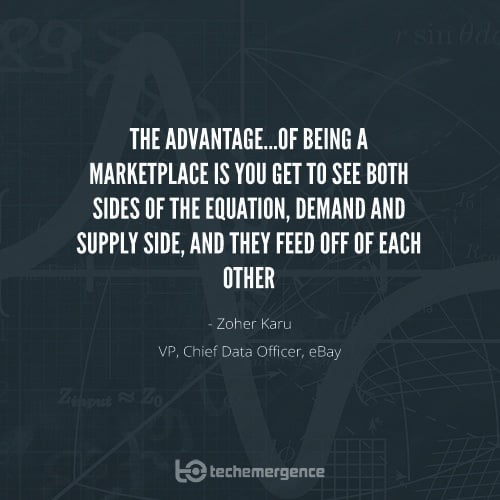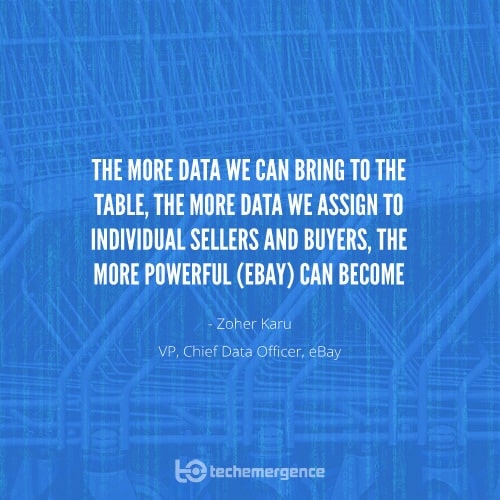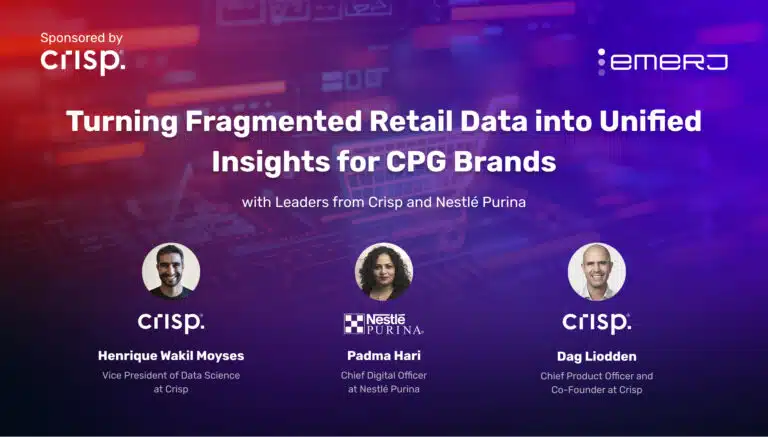Episode Summary: At Facebook headquarters, I learned there are 1 billion active users every month. In a more recent interview at eBay headquarters in San Jose, l learned that the well-known digital store has over 1 billion products for sale. eBay is, without a doubt, the world’s largest marketplace, and there’s enough incoming data to keep a large team of data scientists busy for years. I speak with Zoher Karu, eBay’s chief data officer, about how eBay leverages data and machine learning to create a better experience for its customers and also their sellers, shedding light on important lessons for anyone looking to sell a product online.
_
Expertise: Computer and data science
Recognition in Brief: Prior to joining eBay as VP of Customer Optimization and Data, later promoted to Chief Data Officer, Karu held several positions in business operations, product management and management consulting at Mattersight, Zyman Group, Brickstream and McKinsey & Company. Karu holds a PhD in Electrical Engineering and Computer Science from the Massachusetts Institute of Technology and a BS in Electrical Engineering from Carnegie Mellon University. He is also an author and owner of ZiZi Press, where he published the engineering textbook Signals and Systems Made Ridiculously Simple.
Current Affiliations: VP, Chief Data Officer at eBay
Interview Highlights:
The following is a condensed version of the full audio interview, which is available in the above links on Emerj’s SoundCloud and iTunes stations.
(1:20) I wanted to go first into what eBay’s main applications are of predictive analytics or applying artificial intelligence; you have so many sellers, so many buyers, more data than 99% of the companies of the world – what are the big nuts you guys are trying to crack with AI today?
Zohar Karu: As you know eBay is the world’s biggest marketplace where we’re trying to build and bring together buyers and sellers, and we are always looking for ways to help people succeed on both sides; eBay will be successful when its sellers are successful and if we can arm them with information and help make them more successful, then we’re fueling the engine.
In a way, I would think of eBay as kind of the pulse of the worlds economy, because of the vast scope in size in terms of over 160 million active buyers, we’re in at 190+ countries…we see patterns around the world and patterns in global commerce and we can kind of shed lights on those and help people see what’ going on. Some of the ways we’re employing ML and AI to help the buy-in side of things is to understand individual customers’ individual preferences…we have over a 1 billion different items for sale on eBay, and we can use advanced data science techniques to help you shape that list for individual people.
For example, we might try to predict, out of the many different categories of things we sell on eBay, which category are you likely to be most interested in buying next, and we do that by looking at some of your past behavior on eBay, your search behavior, how you’ve interacted with eBay, how other people who are like you have interacted with eBay.
(7:06) On the personalization side for the consumers, am I proper in thinking of this in some way like the Pandoras and Amazons of the world, of detecting my behavior, looking at aggregate behavior…and presenting those as more likely search results and more likely home page results; it’s (eBay) that kind of an engine?
ZK: It’s basically – like on Netflix it’ll say movies recommended of you, and it’s trying to do that based off a combination of, like you said, of what might be hot right now, but a combination of what you are interested in, so there’s a lot of predictive analytics behind that, just like if we’re trying to surface which deals on eBay you might be most interested in, we can try to filter down from all the different, what we would consider deals, and say, ‘hey, you’d probably be the most interested in this one’.
Because everybody is different, we can try to understand those differences and interact in different ways, and some people are brand new to the eBay platform, some people are 20 year veterans of the eBay platform, some have interest in skiing, others have interest in electronics – it’s how do I think about the things that are going to ignite their passions and deliver them to people.
(8:46) Is there anything other than eBay information that you can gather; is literally (people’s) activity on their platform how we define this contact, or are there other ways?
ZK: There are external data sources that you can try to bring into the platform; there have been a lot of companies that have tried different attempts at understanding behavior on social platforms…those are challenging, a lot of those conversations are not necessarily about commerce intent, they’re just conversations; and of course tying to match that with your eBay data poses its own challenges …but the more data we can bring to the table, and the more data we are able to assign to individual sellers and buyers, the more powerful this can become.
(9:55) The consumer side, I think it’s a lot more common for my interviews and maybe even for people who have heard about it i.e. tailoring messages for consumers. Your work with sellers is really what makes eBay different than anyone else who sells things on the Internet…as you move forward in the next 5 years or so, how do you want to be leveraging your data to make it a richer experience for sellers?
ZK: I think the advantage and power of being a marketplace is, as you said, you get to see both side of the equations, you have the demand side and the supply side, and they feed off of each other, so if we can uncover demand signals, we feed the information to sellers, that brings people to the platform, more people come to the platform, which causes more people to list things to sell and they feed off of each other…we have the luxury of being able to fuel that flywheel.
The challenge is, we want the world to shop first on eBay, we want people to think of eBay as a place where they can find and fulfill their passions. We have a very long tail of inventory – yes, you can find the brand new iPhone 7 when it comes out,but you can also find an iPhone 5, for example, and you can’t find that easily in a lot of other places – so this brand spectrum of value gives consumers a great deal of options and flexibility that other places don’t have.
(14:30) It’s interesting to see how you folks are leveraging data science here; when you look at what you’re doing and maybe look across the business landscape…is there anything that you might even consider close to being low-hanging fruit for small- and medium-sized businesses who are aiming to glean real value from data science…to drive business initiatives as you are, what do you see as those opportunities for the littler guys of the world?
ZK: My biggest advice and starting point is make sure that your data is actually organized around your customer. Most businesses, especially those starting, have their data oriented by store or by country or by region or by channel…but they won’t have the data organized by customer; how much did your highest value customer buy, or who are your highest value customers? Do you know how often they come and shop? Really understanding things from a customer perspective will go a long way toward allowing you to treat different customers differently.
Other areas that you tap into as you get more sophisticated – real-time is becoming a real trend; you can look at yesterday’s sales, and try to cater to that, but do you know how much you sold in the last 20 minutes, do you know what’s hot right now, and can you react to data in real time? And especially in the digital world, we have the ability to react in real-time…and that’s ultimately where you get into machine learning and AI…now we’ve really reached the sweet spot in terms of compute power and memory power and the amount of data that you can use to throw at problems that aren’t typically solved with traditional approaches.
For example, take the home page of eBay or any website, could a machine auto layout that for every person as opposed to a human saying I’ll put this here etc.? There will be a combination of human-assisted machines is the way I think about it, I mean a machine is not going to completely figure it out on its own, however if that one thing that you’ve got in your lower left corner is not selling as well as it could, a machine could swap it out with something automatically as opposed to waiting for a human say ‘Oh I’ll look at the data tomorrow, and let me decide it wasn’t selling well, and I’ll switch it out then’.



























